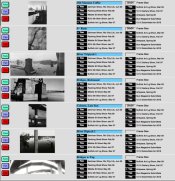Hi,
I have organized and archived my negatives from the beginning at the binders.
Every film has running number, so identification of the single negative is not a problem.
In the binder is also data sheet, where I have wrote all necessary data of each negative. There's also contact print and printing charts.
Everything hand written without any kind of exposure data sheet.
That works, but the searching of particular negative is really painful at the times.
If I remember negative, then it's quite easy to found, but if I am looking for, say negative that contains moon, then I am lost.
I probably remember couple but have forget many.
Solutions?
Just some thoughts...
- Keep database with keywords on the computer. This I have partially done at least five times. Never finished the program and/or database..
- Nowadays as I scan most of my negatives for web, it could also be easy to add keywords as tags to the scanned picture. Could this be the best aproach?
Ofcourse, If I lost my scanned pictures, then I will lost my computerized 'database'.
In the first, traditional approach the database can be backuped easily to multiple places so there's no fear of losting it.
Something ofcourse comes to my mind, like doing double work when writing data sheet and then again partially same data to the either computer database or the metadata of the scanned negative.
Is there any handy tools for combining these? For example tool that stores everything in the database and then allow me to print data sheets for binders would be nice.
However, I don't want to reinvent wheel, so I am asking how do you handle all the negatives?
Is keeping data sheet, contact prints and printing data (burn+dodge charts, ...) together with the negatives good idea?
Sometimes I feel that it would be easier to browse thru negatives if I had all contact sheets separated from the negatives. Then I could easily just watch them and perhaps find a picture that I have forgot.
Or is scanning better approach? Scanned pictures are also easy to browse.
I have organized and archived my negatives from the beginning at the binders.
Every film has running number, so identification of the single negative is not a problem.
In the binder is also data sheet, where I have wrote all necessary data of each negative. There's also contact print and printing charts.
Everything hand written without any kind of exposure data sheet.
That works, but the searching of particular negative is really painful at the times.
If I remember negative, then it's quite easy to found, but if I am looking for, say negative that contains moon, then I am lost.
I probably remember couple but have forget many.
Solutions?
Just some thoughts...
- Keep database with keywords on the computer. This I have partially done at least five times. Never finished the program and/or database..
- Nowadays as I scan most of my negatives for web, it could also be easy to add keywords as tags to the scanned picture. Could this be the best aproach?
Ofcourse, If I lost my scanned pictures, then I will lost my computerized 'database'.
In the first, traditional approach the database can be backuped easily to multiple places so there's no fear of losting it.
Something ofcourse comes to my mind, like doing double work when writing data sheet and then again partially same data to the either computer database or the metadata of the scanned negative.
Is there any handy tools for combining these? For example tool that stores everything in the database and then allow me to print data sheets for binders would be nice.
However, I don't want to reinvent wheel, so I am asking how do you handle all the negatives?
Is keeping data sheet, contact prints and printing data (burn+dodge charts, ...) together with the negatives good idea?
Sometimes I feel that it would be easier to browse thru negatives if I had all contact sheets separated from the negatives. Then I could easily just watch them and perhaps find a picture that I have forgot.
Or is scanning better approach? Scanned pictures are also easy to browse.




